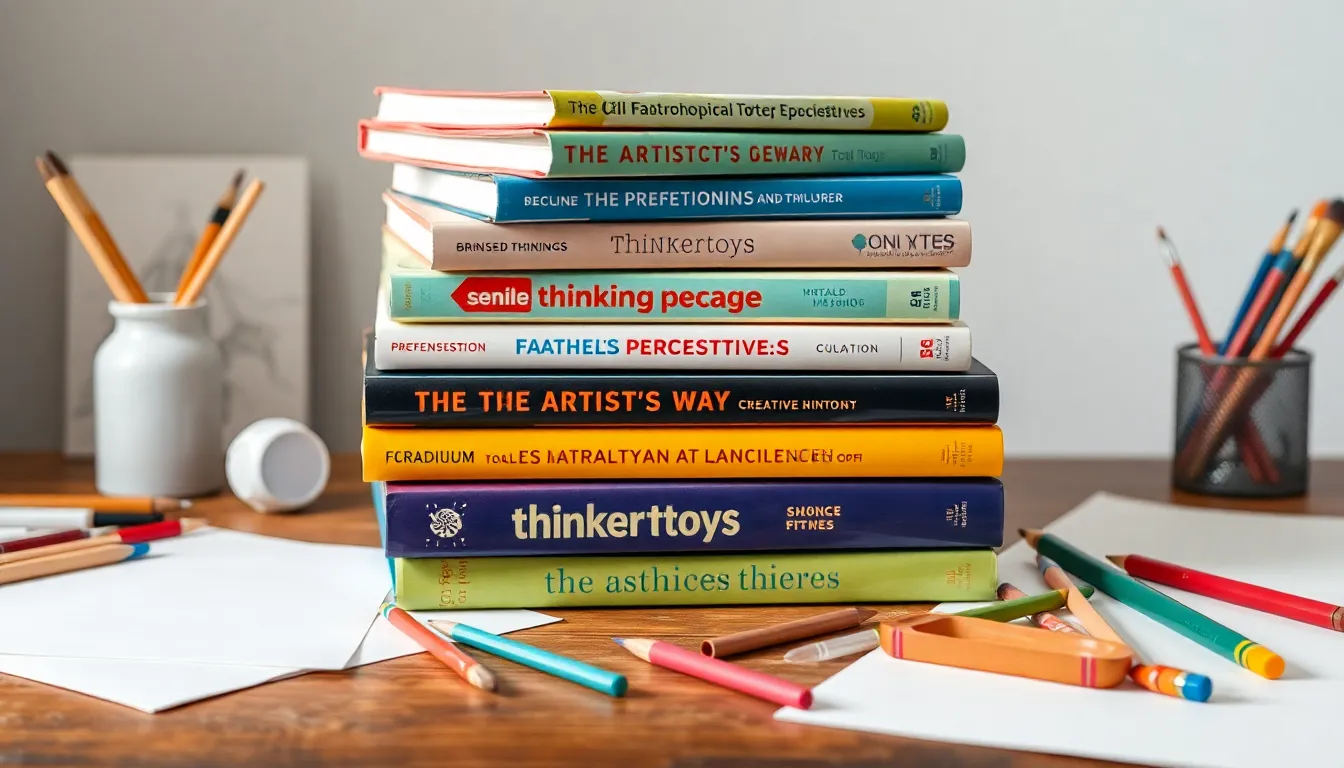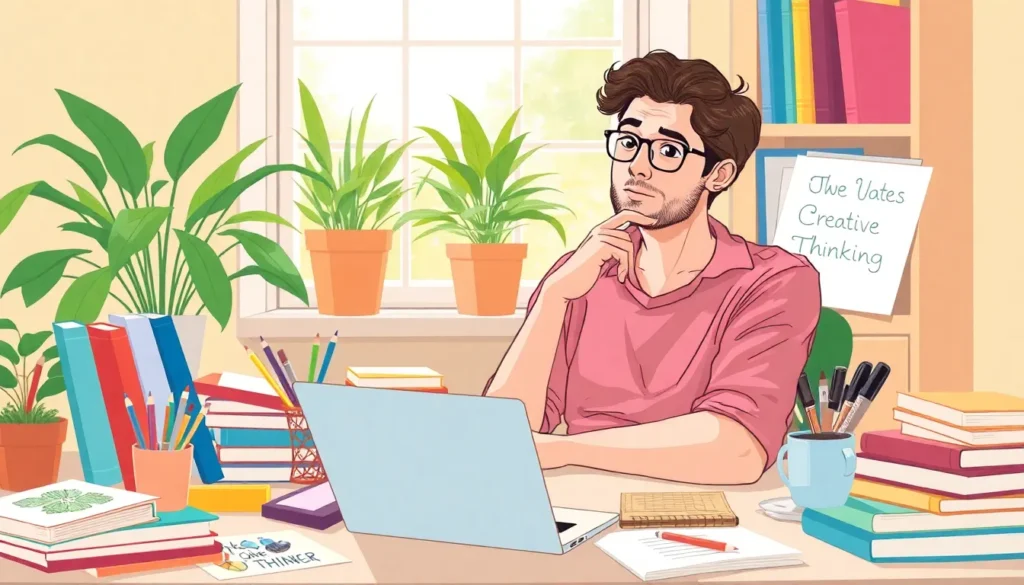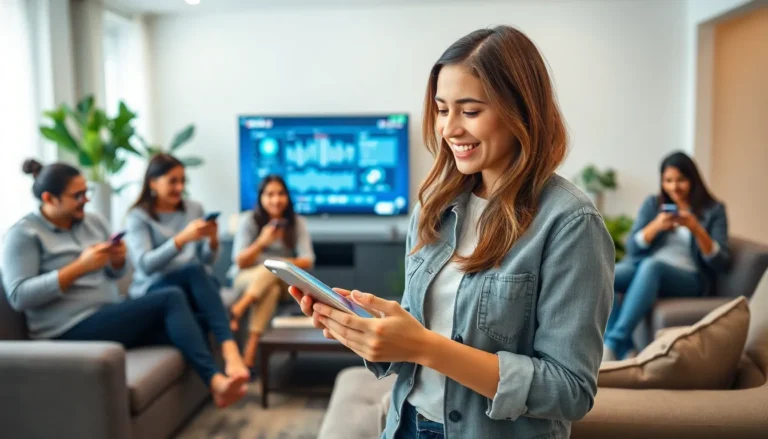In a world where creativity often takes a backseat to routine, finding the spark to ignite fresh ideas can feel like hunting for a unicorn. Yet, the right book can transform that mundane thinking into a vibrant explosion of imagination. Creative thinking books are not just for artists or writers; they’re essential tools for anyone looking to break free from the shackles of conventional thought.
Table of Contents
ToggleImportance Of Creative Thinking
Creative thinking fuels innovation across various fields. Individuals often unlock solutions by seeking out novel ideas and alternatives. Additionally, organizations benefit from a workforce that approaches challenges with originality. Employees who think creatively contribute to more effective problem-solving and increased productivity.
Innovative thinking leads to better decision-making. When individuals explore multiple perspectives, they gain insights that might otherwise remain hidden. This approach enhances collaboration and encourages teams to share unique viewpoints, enriching discussions and outcomes.
Moreover, creative thinking enhances adaptability. In today’s rapidly changing landscape, flexibility proves essential for success. Individuals who embrace creative strategies can pivot quickly, responding effectively to shifting circumstances or unexpected obstacles.
Engaging with creative thinking books cultivates an open mind. These resources often provide techniques and exercises designed to stimulate imagination and promote divergent thinking. Readers expose themselves to various methodologies, gaining new tools for tackling complex problems.
A strong foundation in creative thinking fosters personal and professional growth. As skills develop, individuals often discover new passions and excel in their respective fields. Embracing creativity empowers self-expression and nurtures a deeper understanding of the world.
Creative thinking plays a crucial role in innovation, collaboration, and adaptability. Introducing creative thinking books into one’s life provides a pathway to uncovering limitless possibilities. These resources encourage individuals to approach challenges with enthusiasm and a fresh outlook, ultimately leading to greater achievements.
Top Creative Thinking Books

Numerous creative thinking books offer valuable insights and techniques to enhance imagination and innovative processes. These resources inspire growth, encouraging readers to explore new perspectives and challenge conventional approaches.
Book Recommendations
- “Thinkertoys” by Michael Michalko – This book presents over 100 creativity techniques, making it accessible for individuals across various fields.
- “Steal Like an Artist” by Austin Kleon – This work encourages readers to embrace influence while fostering originality, promoting a mindset of innovation.
- “Creative Confidence” by Tom Kelley and David Kelley – This resource focuses on building creativity within oneself, emphasizing that everyone possesses the potential for imaginative thinking.
- “The Artist’s Way” by Julia Cameron – This classic fosters creative unblock, guiding readers through exercises to rediscover their artistic passions.
Author Insights
Michael Michalko emphasizes practical techniques that spark creative thought, presenting ideas that can be applied immediately.Every book mentioned draws from the author’s unique experiences, enriching the reader’s understanding. Austin Kleon shares anecdotes and practical advice, illustrating how imitating great artists can lead to personal innovation. Tom and David Kelley highlight the importance of fostering a supportive environment that nurtures creativity, stressing that collaboration enhances imaginative processes. Lastly, Julia Cameron encourages introspection, asserting that uncovering one’s inner artist can lead to profound creative breakthroughs.
How To Apply Lessons From These Books
Applying lessons from creative thinking books requires intention and practice. Start by selecting a specific technique that resonates. For instance, “Thinkertoys” offers over 100 methods, allowing readers to choose strategies that best fit their challenges.
Incorporate exercises from “The Artist’s Way.” Engage in daily writing or artistic tasks to cultivate a routine that promotes creativity. Such practices help individuals discover their unique voices and boost confidence.
Embrace the philosophy from “Steal Like an Artist.” It encourages learners to draw inspiration from existing works while adapting them. Creative work thrives on influence, so actively seek inspiration from various sources.
Foster an environment supportive of creativity. Insights from “Creative Confidence” highlight the importance of collaboration and open dialogue. Working with others can lead to spontaneous ideas and innovative solutions.
Reflect on experiences regularly. Journaling thoughts and ideas nurtures self-awareness and personal growth. Set aside time each week to evaluate progress and creativity levels.
Utilize brainstorming sessions effectively. These sessions, inspired by techniques from recommended books, promote open-minded thinking. Encourage all participants to share thoughts without fear of judgment.
Finally, practice adaptability. In creative endeavors, flexibility can lead to unexpected breakthroughs. By remaining open to change, individuals can navigate obstacles creatively and find new pathways to success.
Benefits Of Reading Creative Thinking Books
Reading creative thinking books enhances problem-solving skills. These resources provide innovative strategies, encouraging individuals to break free from traditional thought patterns. Exposure to diverse perspectives fosters adaptability, which becomes essential in dynamic environments.
Imagination flourishes when engaging with these books. Techniques found within their pages stimulate original ideas and promote divergent thinking. Development of creativity leads to improved decision-making, allowing individuals to explore multiple solutions.
Collaboration skills strengthen through shared insights from these books. Discussing concepts with peers cultivates an environment of support and exploration. Organizations benefit from teams that embrace creativity, driving productivity and effective results.
Confidence in one’s creative abilities grows as readers implement practical exercises. Utilizing suggestions from titles like “Creative Confidence” and “The Artist’s Way” encourages daily practice. Regular engagement with these techniques fosters a mindset open to experimentation.
Cultivating an open mind becomes easier with the guidance from various authors. They share valuable advice, emphasizing the importance of introspection and reflection. Vivid examples throughout these books inspire individuals to pursue their artistic passions actively.
Establishing a routine based on lessons derived from creative thinking books leads to discovery. Setting aside time for journaling or brainstorming sessions enhances imaginative thought. In a competitive landscape, those who embrace these strategies thrive, unlocking potential previously unattainable.
Embracing creative thinking books can transform how individuals approach challenges and opportunities. These resources not only stimulate imagination but also cultivate a mindset geared toward innovation. By integrating the techniques and insights from these books into daily routines, readers can enhance their problem-solving skills and adapt to ever-changing environments.
The journey of creativity is ongoing and requires consistent practice and reflection. As individuals explore diverse perspectives and collaborate with others, they’ll find new ways to navigate obstacles. Ultimately, engaging with creative thinking literature empowers individuals to unlock their full potential and achieve remarkable results in both personal and professional realms.










